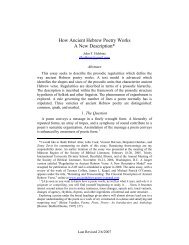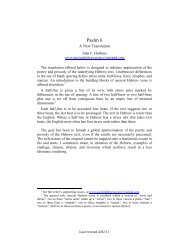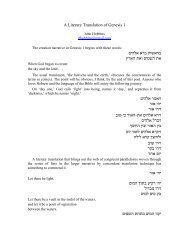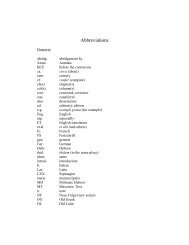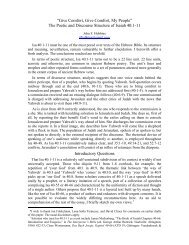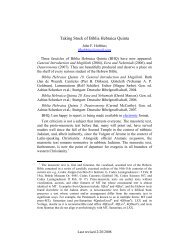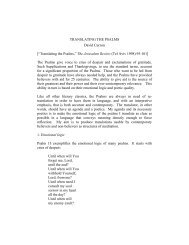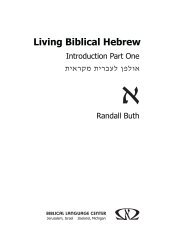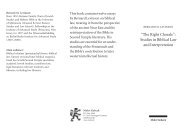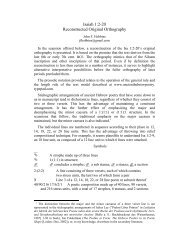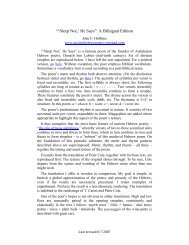Here - Ancient Hebrew Poetry - Typepad
Here - Ancient Hebrew Poetry - Typepad
Here - Ancient Hebrew Poetry - Typepad
- No tags were found...
Create successful ePaper yourself
Turn your PDF publications into a flip-book with our unique Google optimized e-Paper software.
12he chucks the description overboard and thus lightens his load as he sets sailfor more hospitable seas. At what he calls the line level, he develops analternative to more familiar systems of meter in the form of a system ofsyntactic constraints. In addition, he develops an alternative to traditionalanalyses of repetition, parallelism, ellipsis, and other phenomena in the formof a classification using new terminology. O’Connor’s “line” corresponds towhat others call a “half-line,” “colon,” or “hemistich,” and what I call a“verset.”O’Connor’s search for principles of organization in the realm of syntax issuccessful where Collins is not in describing parameters that definewellformedness at one level of the textual hierarchy. It is nonethelessprobable that constraints at more than one level determine the way ancient<strong>Hebrew</strong> verse is constructed. This follows from the fact that language ingeneral and poetry in particular instantiate redundant structures on multiplelevels simultaneously. These structures have metrical properties and conformto a system of ranked constraints and preferences. To say so is merely torepeat a widely held axiom of modern linguistics, one manifestation of whichis Optimality Theory. 28 Language in general and poetry in particular displayiterative, constraint-governed patterns at the levels of phonology, prosodichierarchy, stress alignment, lexical, grammatical, and rhetorical stress,morphology, syntax, sentence intonation, discourse grammar, and groupingand closure preferences. At all these levels, it is our task to isolate patternspeculiar to poetry in the context of those that occur in language moregenerally.The real question is to what degree a particular analysis of stressparallelisms, or of syntax at the verset or line level, state matters as they are.That one level of analysis does not rule out another should be obvious. Itfollows that there is no a priori reason for thinking that O’Connor’s systemof syntactic constraints is incompatible with the analysis of semantic andprosodic equivalences implied by the classical description.O’Connor’s description of what he calls the tropes of repetition,coloration, matching, and gapping clarifies and obscures at the same time. Atthe most abstract level, his system, by no longer singling out parallelism as28Alan Prince and Paul Smolensky, Optimality Theory: Constraint Interaction inGenerative Grammar (Report no. RuCCS-TR-2; New Brunswick: Rutgers UniversityCenter for Cognitive Science, 1993). An archive of Optimality studies is available at:http://roa.rutgers.edu. Introductions: René Kager, Optimality Theory (Cambridge Textbooksin Linguistics; Cambridge: Cambridge University Press, 1999); John J. McCarthy, AThematic Guide to Optimality Theory (Cambridge: Cambridge University Press, 2002).



